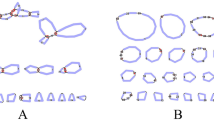Abstract
In the subgenusLeopoldia of the genusMuscari, M. comosum is an exceptional species because it presents the most asymmetrical karyotype of the group and because its only active NOR is located in the fifth chromosome pair, while in the other species it is located in the first or second chromosome pairs (all the species have 2n = 18 chromosomes). SinceM. comosum has a derived karyotype different from those of the other species of the group, the resulting question is whether, in the first and second chromosome pair of this species, ribosomal cistrons persist. Observations after fluorescence in situ hybridization (FISH) using rDNA probes indicate that there are indeed ribosomal loci in the first and second chromosome pairs of this species, although these loci are inactive with respect to nucleolus organization. The location of rDNA regions in another three species of the same genus (M. atlanticum, M. dionysicum andM. matritensis) provides a basis for examining the significance of these findings in relation to the evolution of the ribosomal loci in this genus. Our observations indicate that in the genusMuscari, the largest sites for rRNA genes are not necessarily active, and, therefore, the activation of these regions is not related to the number of copies but to a specific regulation mechanism.
Similar content being viewed by others
References
Amado L., Abranches R., Neves N., Viegas W. (1997) Development-dependent inheritance of 5-azacytidine-induced epimutations in Triticale: analysis of rDNA expression patterns. Chromosome Research 5: 445–450.
Amemiya C. T., Gold J. R. (1988) Chromomycin A3 stains nucleolar organizer regions of fish chromosomes. Copeia 1: 226–231.
Bentzer B. (1973) Taxonomy, variation and evolution in representatives ofLeopoldia Parl. (Liliaceae) in the southern and central Aegean. Botaniska Notiser 126: 69–132.
Bentzer B. (1974) Karyotypes and meiosis inLeopoldia Parl. (Liliaceae) from the Southern and Central Aegean (Greece). Botaniska Notiser 127: 69–86.
Cuñado N., Callejas S., García M. J., Fernández A., Santos J. L. (1996) The pattern of zygotene and pachytene pairing in allotetraploidAegilops species sharing the U genome. Theor. Appl. Genet. 93: 1152–1155.
Cuñado N., Santos J. L. (1998) A method for fluorescence in situ hybridization against synaptonemal complex-associated chromatin of plant meiocytes. Exp. Cell Res. 239: 179–182.
Díez M., Puertas M. J. (1986) Quantitative analysis of the formation of nucleoli inLocusta migratoria. Can. J. Genet. Cytol. 28: 207–218.
Dubcovsky J., Dvorak J. (1995) Ribosomal-RNA multigene loci-nomads of the Triticeae genomes. Genetics 140: 1367–1377.
Fukui K., Ohmido N., Khush G. S. (1994) Variability in rDNA loci in the genusOryza detected through fluorescence in situ hybridization. Theor. Appl. Genet. 87: 893–899.
Gerlach W. L., Bedbrook J. R. (1979) Cloning and characterization of ribosomal RNA genes from wheat and barley. Nucleic Acid Res. 7: 1869–1885.
Goodpasture C., Bloom S. E. (1975) Visualization of nucleolar organiser regions in mammalian chromosomes using silver-staining. Chromosoma 53: 37–50.
Howell W. M. (1982) Selective staining of nucleolus organizer regions (NORs). Cell Nucleus 11: 80–142.
Lacadena J. R., Cermeño M. C., Orellana J., Santos J. L. (1984) Evidence for wheat-rye nucleolar competition (amphiplasty) in Triticale by silver-staining procedure. Theor. Appl. Genet. 67: 207–213.
Matsui S. I., Sasaki M. (1973) Differential staining of nucleolus organizers in mammalian chromosomes. Nature 246: 148–150.
McClintock B. (1934) The relation of a particular chromosomal element to the development of the nucleoli inZea mays. Z. Zellforsch. Mikrosk. Anat. 21: 294–328.
McGrath J. M., Helgeson J. P. (1998) Differential behavior ofSolanum brevidens ribosomal DNA loci in a somatic hybrid and its progeny with potato. Genome 41: 435–439.
Neves N., Heslop-Harrison J. S., Viegas W. (1995) RNA activity and control of expression mediated by methylation and imprinting during embryo development in wheat × rye hybrids. Theor. Appl. Genet. 91: 529–533.
Ritossa F. M., Spiegelman S. (1965) Localisation of DNA complementary to ribosomal RNA in the nucleolus organiser region ofDrosophila melanogaster. Proc. Nacl. Acad. Sci. USA 53: 737–745.
Ruiz Rejón C., Lozano R., Ruiz Rejón M. (1987) Genetic variability inMuscari comosum L. (Liliaceae). II. Characterization and effects on chiasma formation of the polymorphic variants of chromosome 2. Genome 29: 19–26.
Ruiz Rejón C., Lozano R., Ruiz Rejón M. (1990a) A cytogenetic analysis of the chromosomes in two related species of the genusMuscari (Liliaceae). Genome 33: 729–732.
Ruiz Rejón C., Lozano R., Ruiz Rejón M. (1990b) Genetic variability inMuscari comosum L. (Liliaceae). IV. Geographical distribution and adaptative role of the polymorphic variants of chromosome 2. Genetica 81: 133–142.
Ruiz Rejón M., Oliver J. L. (1981) Genetic variability inMuscari comosum (Liliaceae). I. A comparative analysis of chromosome polymorphism in Spanish and Aegean populations. Heredity 47: 403–407.
Schubert I. (1984) Mobile nucleolus organizing regions (NORs) inAllium (Liliaceae s.lat.)?-Inference from the specificity of silver staining. Plant Syst. Evol. 144: 291–305.
Schubert I., Wobus U. (1985) In situ hybridization confirms jumping nucleolus organizing regions inAllium. Chromosoma 92: 143–148.
Stebbins G. L. (1971) Chromosomal evolution in higher plants. Arnold, London.
Tutin T. G. et al. (eds.) (1980) Flora Europaea, vol. 5. Cambridge University Press, London.
White M. J. D. (1973) Animal Cytology and Evolution, 3rd edn. Cambridge University Press, Cambridge.
Author information
Authors and Affiliations
Rights and permissions
About this article
Cite this article
Cuñado, N., De la Herrán, R., Santos, J.L. et al. The evolution of the ribosomal loci in the subgenusLeopoldia of the genusMuscari (Hyacinthaceae). Pl Syst Evol 221, 245–252 (2000). https://doi.org/10.1007/BF01089296
Received:
Accepted:
Issue Date:
DOI: https://doi.org/10.1007/BF01089296




